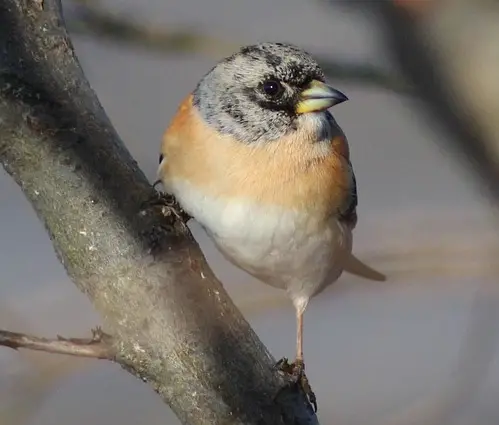If the Great British weather is confusing you, just think what it must be doing for the bramblings who like a clear distinction in the weather to suit their simple palette of nuts and seeds in the winter and insects in the summer!
The dish of the day is usually what prompts them to fly away or to stay put…
But how many of us know what a brambling is, and would you be able to spot one in your garden?
They’re very similar to chaffinches in shape and size – the male has a blackhead in the summer, and an orange breast with a white tummy and a yellow bill, except in the summer when their bill is black, so yes, quite distinctive and a pleasure to see in the garden.
The females are less distinctive than the males and often get mistaken for chaffinches until you look at the bramblings’ rump, which is distinguishable by being white.
Their numbers tend to fluctuate from one year to the next, depending on the beech mast availability in Finland, Russia, and Scandinavia, where they usually like to breed.
Unless the beech nuts are particularly yummy over here, that is.

Fly Away
Bramblings usually migrate to warmer climates, but a tiny number like to stay and occasionally breed here, so we were very honoured to see one in the garden amidst the chaffinches.
In the winter, bramblings tend to gather in large flocks where its food is – this is usually the seeds of the beech tree.
They particularly like beech nuts – so much, so they are happy to shop around until they find the ones up to scratch.
They usually arrive back from their foreign travels in September until March and April when they set off for their hols.
Some bramblings stay longer, and parts of the UK, particularly in the East, are lucky enough to see them through the breeding season.
On the menu…
I recently saw a brambling pecking away at our hanging seed feeder in the garden. Still, usually, at this warmer time of year, they like insects, beetles, and caterpillars, not the seeds, berries, and beech-mast they find on the ground or the feeder which is definitely their winter fodder.
They do tend to love sunflower seeds though, so if you fancy filling your garden with these delightful songbirds and their babies, then perhaps this is something for their menu which you can dish up, as not only are they a nice change for them they’ll also meet their optimal dietary requirements.
I was surprised to find how readily bramblings will feed on ‘takeaways’ provided for them by way of the ground feeder, table, or just on the ground.
They like to feed on the ground, so if you fancy putting your seed mixes or peanut granules on a low bird table or the ground, I wouldn’t be surprised to see a few visiting bramblings still – even more so if you have wooded areas surrounding your garden.
When the rain does stop, we should then see the beginnings again of the bramblings return to their favourite summer dish of insects – the juicier, the better!
